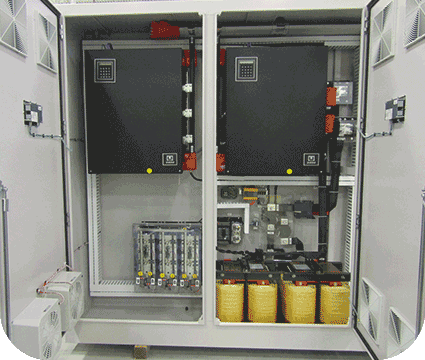Battery Simulator / Emulator
EV Battery simulators / emulators for testing electric vehicle propulsion and powertrain systems, including traction inverters, E-motors & E-axles.
EV Battery simulators / emulators for testing electric vehicle propulsion and powertrain systems, including traction inverters, E-motors & E-axles.

Test your EV and HEV propulsion systems with a UNICO EV Battery
Simulator / Emulator.
This outstanding EV battery simulator / emulator comes standard with programmable voltage and current controls for resistance simulation, so you can quickly test and view results for hundreds of different battery designs on powertrain performance. With the programmable slew rate, you can precisely regulate the response to a change in both the requested output and changes in the load. And with a full filtered output, systems can be designed with minimal current and voltage ripple – typical ripple is less than 1%.
Testing of different battery designs and power ratings on the EV propulsion system to evaluate efficiency, durablilty, and performance response of the traction inverter, E-Motor, and E-Axle.
Unico inverters achieve a high sampling frequency with silicon IGBTs, ranging from 1 kHz (1.0 ms) to 10 kHz (0.1 ms). This provides quick response to changing commands or load levels. Performance can be customized to your application.
Common DC bus architecture allows for add-on dynamometer controls sections, high efficiency, fully regenerative current source and sink capability. Higher voltage and current possible by connecting units in series and parallel. The optional ripple generator (inject AC wave on top of DC output) is available for specialized testing. Full bridge models have 0-volt operation for applications like fuel cell testing.
For stand-alone battery emulators, systems can be designed to recycle regenerated power back to the three-phase grid bus. This eliminates the need to dump valuable power into resistors.
With the programmable slew rate, you can precisely regulate the response to a change in both the requested output and changes in the load. And with a full filtered output, systems can be designed with minimal current and voltage ripple – typical ripple is less than 1%.
Control voltage to a constant or dynamic set point, regardless of the current draw. This removes the variability of battery performance, so you can accurately test efficiency and response of your vehicle’s traction inverter, E-Motor, and E-Axle.
Program voltage to decrease and current to increase, in response to a load, simulating the impedance of a high voltage EV battery. This will help you determine the actual performance of how the battery and EV powertrain will perform under real world scenario testing. You can also set a specific limit or constant current level for testing applications that require it.
Supports most industry standard communication protocol, making it versatile to work with any available automation system platform. A high-speed communications interface is optionally available to accept commands from existing customer controllers that are used to generate test profiles. Wired and fiber-optic options are available. Supported protocols include:
Built-in safety and control interlocks are hardwired, opto-isolated, and software configurable, so you can match the demands of your EV propulsion system under test.

| AC Input | 480VAC, 3Ph, 50/60Hz (other voltages available on request) | |
|---|---|---|
| Ambient | Up to 40°C, max l000m above sea level, 95%RH non-condensing enclosure | |
| Enclosure | NEMA 1 (other options available upon request)Cabinet Paint | |
| Cooling | Air cooled (water cooled or airconditioned cabinets upon request) | |
| Cabinet Paint | RAL 7035 rough semi-gloss poly powder finish | |
| Certification Compliance | UL (other certifications available) | |
| Control Modes | Constant current, constant voltage, constant power | |
| Control | Local and remote | |
| Built in remote interface | Analog as well as RS-422, RS-485, two ports (other interface and protocol, see options below) | |
| Safety and control interlocks | Hardwired, opto-isolated, software configurable | |
| Measurement Accuracy | 0.05% (system calibration required) | |
| Measurement Accuracy | 0.05% (system calibration required) | |
| Voltage Ripple | 0.10% | |
| Current Ripple | 0.10% |

| Isolation transformer | Various sizes as requiredr |
|---|---|
| Insulation monitoring | Available |
| Remote voltage sensings | Available |
| Additional analog and digital input, output | Technical discussion required |
| Cabinet paint finish | Customer specific |
| Protection class | NEMA 12 |
| External communication interface | CANopen, CC-Link, ControlNet, DeviceNet, Ethernet, EtherCAT (async), Interbus, LonWorks, Modbus Plus, Profibus DPV1, Profibus Master, EtherCat (sync) |
Testing of different battery designs and power ratings on the EV propulsion system to evaluate efficiency, durablilty, and performance response of the traction inverter, E-Motor, and E-Axle.
Unico inverters achieve a high sampling frequency with silicon IGBTs, ranging from 1 kHz (1.0 ms) to 10 kHz (0.1 ms). This provides quick response to changing commands or load levels. Performance can be customized to your application.
Common DC bus architecture allows for add-on dynamometer controls sections, high efficiency, fully regenerative current source and sink capability. Higher voltage and current possible by connecting units in series and parallel. The optional ripple generator (inject AC wave on top of DC output) is available for specialized testing. Full bridge models have 0-volt operation for applications like fuel cell testing.
For stand-alone battery emulators, systems can be designed to recycle regenerated power back to the three-phase grid bus. This eliminates the need to dump valuable power into resistors.
With the programmable slew rate, you can precisely regulate the response to a change in both the requested output and changes in the load. And with a full filtered output, systems can be designed with minimal current and voltage ripple – typical ripple is less than 1%.
Control voltage to a constant or dynamic set point, regardless of the current draw. This removes the variability of battery performance, so you can accurately test efficiency and response of your vehicle’s traction inverter, E-Motor, and E-Axle.
Program voltage to decrease and current to increase, in response to a load, simulating the impedance of a high voltage EV battery. This will help you determine the actual performance of how the battery and EV powertrain will perform under real world scenario testing. You can also set a specific limit or constant current level for testing applications that require it.
Supports most industry standard communication protocol, making it versatile to work with any available automation system platform. A high-speed communications interface is optionally available to accept commands from existing customer controllers that are used to generate test profiles. Wired and fiber-optic options are available. Supported protocols include:
Built-in safety and control interlocks are hardwired, opto-isolated, and software configurable, so you can match the demands of your EV propulsion system under test.
| AC Input | 480VAC, 3Ph, 50/60Hz (other voltages available on request) | |
|---|---|---|
| Ambient | Up to 40°C, max l000m above sea level, 95%RH non-condensing enclosure | |
| Enclosure | NEMA 1 (other options available upon request)Cabinet Paint | |
| Cooling | Air cooled (water cooled or airconditioned cabinets upon request) | |
| Cabinet Paint | RAL 7035 rough semi-gloss poly powder finish | |
| Certification Compliance | UL (other certifications available) | |
| Control Modes | Constant current, constant voltage, constant power | |
| Control | Local and remote | |
| Built in remote interface | Analog as well as RS-422, RS-485, two ports (other interface and protocol, see options below) | |
| Safety and control interlocks | Hardwired, opto-isolated, software configurable | |
| Measurement Accuracy | 0.05% (system calibration required) | |
| Measurement Accuracy | 0.05% (system calibration required) | |
| Voltage Ripple | 0.10% | |
| Current Ripple | 0.10% |
| Isolation transformer | Various sizes as requiredr |
|---|---|
| Insulation monitoring | Available |
| Remote voltage sensings | Available |
| Additional analog and digital input, output | Technical discussion required |
| Cabinet paint finish | Customer specific |
| Protection class | NEMA 12 |
| External communication interface | CANopen, CC-Link, ControlNet, DeviceNet, Ethernet, EtherCAT (async), Interbus, LonWorks, Modbus Plus, Profibus DPV1, Profibus Master, EtherCat (sync) |
Our sales professionals are eagerly awaiting your questions. Fill out the form below and we’ll be in touch. If you’re looking for product support click here
| Cookie | Duration | Description |
|---|---|---|
| cookielawinfo-checkbox-analytics | 11 months | This cookie is set by GDPR Cookie Consent plugin. The cookie is used to store the user consent for the cookies in the category "Analytics". |
| cookielawinfo-checkbox-functional | 11 months | The cookie is set by GDPR cookie consent to record the user consent for the cookies in the category "Functional". |
| cookielawinfo-checkbox-necessary | 11 months | This cookie is set by GDPR Cookie Consent plugin. The cookies is used to store the user consent for the cookies in the category "Necessary". |
| cookielawinfo-checkbox-others | 11 months | This cookie is set by GDPR Cookie Consent plugin. The cookie is used to store the user consent for the cookies in the category "Other. |
| cookielawinfo-checkbox-performance | 11 months | This cookie is set by GDPR Cookie Consent plugin. The cookie is used to store the user consent for the cookies in the category "Performance". |
| viewed_cookie_policy | 11 months | The cookie is set by the GDPR Cookie Consent plugin and is used to store whether or not user has consented to the use of cookies. It does not store any personal data. |